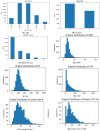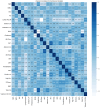COVID-19 Hierarchical Classification Using a Deep Learning Multi-Modal
- PMID: 38676257
- PMCID: PMC11053684
- DOI: 10.3390/s24082641
COVID-19 Hierarchical Classification Using a Deep Learning Multi-Modal
Abstract
Coronavirus disease 2019 (COVID-19), originating in China, has rapidly spread worldwide. Physicians must examine infected patients and make timely decisions to isolate them. However, completing these processes is difficult due to limited time and availability of expert radiologists, as well as limitations of the reverse-transcription polymerase chain reaction (RT-PCR) method. Deep learning, a sophisticated machine learning technique, leverages radiological imaging modalities for disease diagnosis and image classification tasks. Previous research on COVID-19 classification has encountered several limitations, including binary classification methods, single-feature modalities, small public datasets, and reliance on CT diagnostic processes. Additionally, studies have often utilized a flat structure, disregarding the hierarchical structure of pneumonia classification. This study aims to overcome these limitations by identifying pneumonia caused by COVID-19, distinguishing it from other types of pneumonia and healthy lungs using chest X-ray (CXR) images and related tabular medical data, and demonstrate the value of incorporating tabular medical data in achieving more accurate diagnoses. Resnet-based and VGG-based pre-trained convolutional neural network (CNN) models were employed to extract features, which were then combined using early fusion for the classification of eight distinct classes. We leveraged the hierarchal structure of pneumonia classification within our approach to achieve improved classification outcomes. Since an imbalanced dataset is common in this field, a variety of versions of generative adversarial networks (GANs) were used to generate synthetic data. The proposed approach tested in our private datasets of 4523 patients achieved a macro-avg F1-score of 95.9% and an F1-score of 87.5% for COVID-19 identification using a Resnet-based structure. In conclusion, in this study, we were able to create an accurate deep learning multi-modal to diagnose COVID-19 and differentiate it from other kinds of pneumonia and normal lungs, which will enhance the radiological diagnostic process.
Keywords: COVID-19; CXR; artificial intelligence; deep learning; diagnosis; hierarchical; image classification; multi-classes; multi-modal; pneumonia.
Conflict of interest statement
The authors declare no conflict of interest.
Figures
















Similar articles
-
COVID-19 identification in chest X-ray images on flat and hierarchical classification scenarios.Comput Methods Programs Biomed. 2020 Oct;194:105532. doi: 10.1016/j.cmpb.2020.105532. Epub 2020 May 8. Comput Methods Programs Biomed. 2020. PMID: 32446037 Free PMC article.
-
Deep Learning Algorithm for COVID-19 Classification Using Chest X-Ray Images.Comput Math Methods Med. 2021 Nov 9;2021:9269173. doi: 10.1155/2021/9269173. eCollection 2021. Comput Math Methods Med. 2021. PMID: 34795794 Free PMC article.
-
Chest X-ray image phase features for improved diagnosis of COVID-19 using convolutional neural network.Int J Comput Assist Radiol Surg. 2021 Feb;16(2):197-206. doi: 10.1007/s11548-020-02305-w. Epub 2021 Jan 9. Int J Comput Assist Radiol Surg. 2021. PMID: 33420641 Free PMC article.
-
Development and integration of VGG and dense transfer-learning systems supported with diverse lung images for discovery of the Coronavirus identity.Inform Med Unlocked. 2022;32:101004. doi: 10.1016/j.imu.2022.101004. Epub 2022 Jul 8. Inform Med Unlocked. 2022. PMID: 35822170 Free PMC article. Review.
-
GACDN: generative adversarial feature completion and diagnosis network for COVID-19.BMC Med Imaging. 2021 Oct 21;21(1):154. doi: 10.1186/s12880-021-00681-6. BMC Med Imaging. 2021. PMID: 34674660 Free PMC article. Review.
Cited by
-
Deep learning approaches for classification tasks in medical X-ray, MRI, and ultrasound images: a scoping review.BMC Med Imaging. 2025 May 7;25(1):156. doi: 10.1186/s12880-025-01701-5. BMC Med Imaging. 2025. PMID: 40335965 Free PMC article.
-
Deep Learning Network Selection and Optimized Information Fusion for Enhanced COVID-19 Detection: A Literature Review.Diagnostics (Basel). 2025 Jul 21;15(14):1830. doi: 10.3390/diagnostics15141830. Diagnostics (Basel). 2025. PMID: 40722579 Free PMC article. Review.
References
-
- COVID-19 Cases|WHO COVID-19 Dashboard. Datadot. [(accessed on 20 January 2024)]. Available online: https://data.who.int/dashboards/covid19/cases.
-
- Chowdhury M.E.H., Rahman T., Khandakar A., Mazhar R., Kadir M.A., Bin Mahbub Z., Islam K.R., Khan M.S., Iqbal A., Al Emadi N., et al. Can AI Help in Screening Viral and COVID-19 Pneumonia? IEEE Access. 2020;8:132665–132676. doi: 10.1109/ACCESS.2020.3010287. - DOI
-
- Maharjan N., Thapa N., Magar B.P., Maharjan M., Tu J. COVID-19 Diagnosed by Real-Time Reverse Transcriptase-Polymerase Chain Reaction in Nasopharyngeal Specimens of Suspected Cases in a Tertiary Care Center: A Descriptive Cross-sectional Study. J. Nepal Med. Assoc. 2021;59:464–467. doi: 10.31729/jnma.5383. - DOI - PMC - PubMed
MeSH terms
Grants and funding
LinkOut - more resources
Full Text Sources
Medical

